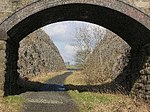Alstonefield

Alstonefield (alternative spelling: Alstonfield) is a village and civil parish in the Peak District National Park and the Staffordshire Moorlands district of Staffordshire, England about 7 miles (11 km) north of Ashbourne, 10 miles (16 km) east of Leek and 16 miles (26 km) south of Buxton. The parish had a population of 274 according to the 2001 census, increasing to 304 at the 2011 census.The village has two pubs; The George and The Watts Russell Arms. The civil parish also contains the hamlets of Hopedale, Stanshope and Milldale. In Wilson's 1870–1872 Imperial Gazetteer of England and Wales, the spellings Allstonefield and Allstonfield were used.The poet and writer Charles Cotton (28 April 1630 – 16 February 1687), best known for translating the work of Michel de Montaigne from the French, for his contributions to The Compleat Angler and for the influential The Compleat Gamester, was born in the village.
Excerpt from the Wikipedia article Alstonefield (License: CC BY-SA 3.0, Authors, Images).Alstonefield
Top Of Hope, Staffordshire Moorlands
Geographical coordinates (GPS) Address Nearby Places Show on map
Geographical coordinates (GPS)
| Latitude | Longitude |
|---|---|
| N 53.09682 ° | E -1.8077 ° |
Address
Top Of Hope
Top Of Hope
DE6 2FR Staffordshire Moorlands
England, United Kingdom
Open on Google Maps









